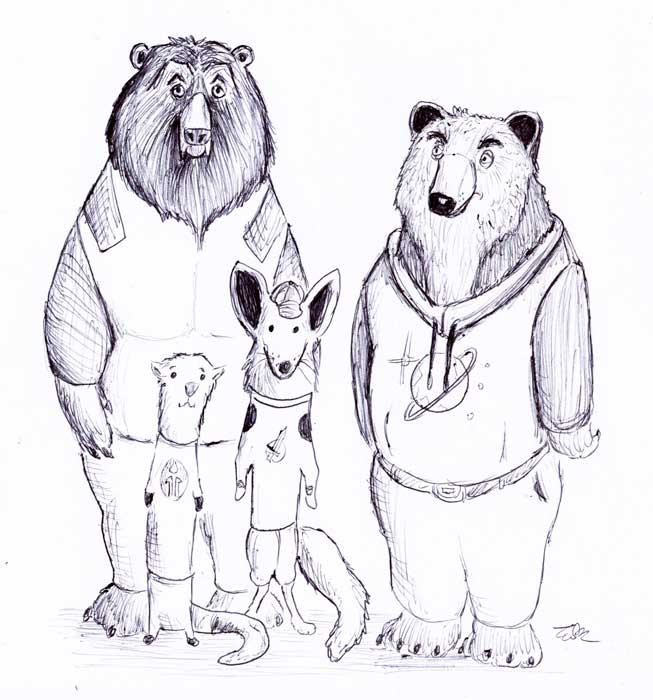
Lesbians and gay men have become normalized in pop culture to a point that terms we use to describe one another have become more commonplace. I was even asked by co-worker to define another staff member by these images.
In an effort to explain some differences, here’s how body image types break down for gay men.
So let’s start with twinks. Generally speaking, these are younger gay men who have a thin to slimly athletic build. Also, they don’t have a lot of body hair, and the chest is usually smooth.
Some guys will shave their chests and armpits to conform to this body image. I think that the term came from Twinkies. You know — young, dumb and full of … moving on.
Up next are the otters. They tend to be hairier overall, still with that thin to slimly athletic build. I’ve seen guys of various ages take the image label of an otter, though it tends to be men under 40.
Closely related to the otters are the foxes. Basically a fox is an otter over forty. One buddy of mine described foxes as the cougars of the gay male community.
Then we have the bears. Like otters, men of various ages identify as a bear. These are larger-bodied or muscular-bodied men that have body hair. Think about the large-bodied construction workers that you may see on Caltrans job sites or a furry bodybuilder.
Finally we have cubs. These are the bears that don’t have body hair.
Sometimes there may be a reference to a gay man as a daddy. While this generally is used to describe the elder partner in a cross-generational relationship, there is a component of dominance when it is used as a self-identifier.
On top of all that there are those who identify as chasing a certain type. Bear-chaser, twink-chaser, etc.
People should be careful applying these terms to gay men they know. Some of us are extremely sensitive to the type we identify with.
At the end of the day, these are often the terms used to filter results on Grindr, the gay Tinder, or other such dating (I mean “dating”) websites or apps. These terms don’t reflect the many variations of men’s bodies. Some people reject these images altogether.
While these images may seem humorous, on the surface they still reflect a society that places too much importance on such trivial things. Despite the widespread use of these terms, they still carry their own stereotypes.
Joseph Rogers can be reached at opinioneditor@theorion.com or @JosephLRogers1 on Twitter.






Lion // Jan 22, 2025 at 1:10 pm
What other anima body types can be used to describe oneself?
Cinett // Nov 17, 2024 at 10:14 pm
Bears is a rough category cause there are like large chubby bears and muscle bears. And cubs are not a hairless bear those are typically referred to as either bears or chubs( for those that don’t think they are furry enough to be a bear) but again bear is a weird term. Like I think of a hairless muscle bear with a beard and a lumbersnack. And often most marketing for bear nights are muscle bear exclusive not really full bear experience worthy. And then people show up to events thinking they will only see one body type and see every kind of bear instead
caelin // Sep 26, 2024 at 2:27 pm
okay 1. bears are defined by being fat. the bear movement was started by people who wanted to push back against heteronormative beauty standards for men and 2. why label them as harmful and only used as “types” a lot of people self id as these things and take pride in it! i know this is just an opinion piece but this really isn’t a great article
Jon // Jan 28, 2024 at 1:25 pm
Gay men (especially younger) often define themselves by these labels. YOU ARE YOU. Labels are just types.
Yohanan // Nov 26, 2023 at 3:23 am
As someone who is a younger gay and definitely newer to the dating scene, I don’t super agree with labeling everything, but this article was well written and helped explain a lot of unknown terms for me thanks!

Peter WESTON // Jul 14, 2023 at 11:47 pm
A cub is a young(er) guy who will become a bear when he gets older,NOT a bear with no hair.
Dan // Sep 13, 2022 at 5:43 am
I’ve never met a queer man who cared what he was labled by others. Mostly we are strong resilient folks that don’t give a damn what others think! Also for the most part bears also have beards and cubs just are young bears. Lastly I’d think you’d have included stuff like leather daddies, dom/sub and other sub genres.